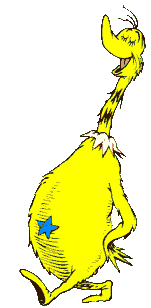Dr. Seuss understood a little bit about tattoos and cultural significance. In his story, “The Sneetches“, the  single distinguishing mark of social difference is the existence or absence of a star “tattoo” on one’s belly. On this beach, the “haves” have the star and the “have nots” well…simply do not. Those without stars suffer social discrimination. Having the star empowers the fortunate Sneetches and causes a struggle of sorts as the two factions battle for control of the beach. The star becomes a symbol of dominance in which inclusion in this elite clan comes with benefits befitting station.
single distinguishing mark of social difference is the existence or absence of a star “tattoo” on one’s belly. On this beach, the “haves” have the star and the “have nots” well…simply do not. Those without stars suffer social discrimination. Having the star empowers the fortunate Sneetches and causes a struggle of sorts as the two factions battle for control of the beach. The star becomes a symbol of dominance in which inclusion in this elite clan comes with benefits befitting station.
As silly as it seems, presented in nonsensical rhyme by Dr. Seuss, the concept is very much alive and in practice amongst gangs and prison affiliations today. Entire books have been written about prison tattoos and the complex symbolism behind them. As per the suggestion of my Research Methods for Writers professor, I was intrigued by this avenue of research. I wanted to look at the idea of group affiliations and the tattoo as an identifying symbol amongst like minded individuals. In short, I wanted to look at “gang” tattoos without delving into modern gang sub-cultures. Initial research led me to another kind of gang, one existing in the dark subconscious of fiction, movies and imagination: the Vampire Clans.
As per the suggestion of my Research Methods for Writers professor, I was intrigued by this avenue of research. I wanted to look at the idea of group affiliations and the tattoo as an identifying symbol amongst like minded individuals. In short, I wanted to look at “gang” tattoos without delving into modern gang sub-cultures. Initial research led me to another kind of gang, one existing in the dark subconscious of fiction, movies and imagination: the Vampire Clans.
Vampires form covens of kindred with the same pursuits, interests, powers and bloodlines. They take some sigil, or mark of their house, often tattooing it on their person. This is not true in all mythology and vampire lore, but is throughout White Wolf’s Vampire, The Masquerade role-playing game. For example, the Toreador clan embraced the black rose:
Vampire clans are always warring amongst themselves. Tattoos are another aspect of their attempt at identification with a, pardon the pun, kindred spirit.
Knowing I was going to write the final piece of this research project as a dark fantasy story, I began to walk down this path. But I didn’t want to do vampires. The magic of the natural world fascinates me. Urban shamanism is a perspective not fully explored and the idea of two battling faerie courts seems rich in material. The fantasy genre has utilized the idea of tattoos as power as well. Wizards of the Coast employs Dragonmark tattoos as magical  power sources and social status symbols.
power sources and social status symbols.
So, this idea of a clan/group association took hold and a story idea began to form. I am going to focus my research on the tattoo as a symbol of power and of clan identification. Power and contesting groups leads most often to conflict and with conflict, I have a story. Here then is the research map illuminating my proposed approach:
